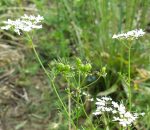 Also known as cilantro and Chinese parsley, coriander is a warm weather annual native to southern Europe and the eastern Mediterranean but is widely cultivated elsewhere as a culinary herb including the US, mostly in California. Growing 2-3′ tall, plants form a basal clump of pinnately compound leaves with the lower ones roundish and lobed, the upper ones finely divided and fern- like. The very small white to pinkish flowers appear on short stalked umbels 2″ across and are followed by brownish yellow, spherical seeds. The leaves, stems, roots and seeds are edible and popular in the cuisine of Mexico, the Middle East, south Asia, and China. Photo Credit Wikimedia Commons
Also known as cilantro and Chinese parsley, coriander is a warm weather annual native to southern Europe and the eastern Mediterranean but is widely cultivated elsewhere as a culinary herb including the US, mostly in California. Growing 2-3′ tall, plants form a basal clump of pinnately compound leaves with the lower ones roundish and lobed, the upper ones finely divided and fern- like. The very small white to pinkish flowers appear on short stalked umbels 2″ across and are followed by brownish yellow, spherical seeds. The leaves, stems, roots and seeds are edible and popular in the cuisine of Mexico, the Middle East, south Asia, and China. Photo Credit Wikimedia Commons
The use of coriander goes back to ancient times. It was found in King Tut’s tomb, was conusmed in 4th century BC China to gain immortality, and was recorded on one of the Linear B tablets from 2nd millennium BC Greece. The ancient Greek physician, Hippocrates used coriander in medicine, and Bronze Age invaders brought the plant to Britain. Pliny the Elder reported that the best coriander came from Egypt. Coriander seeds are mentioned in the Old Testament of the Bible in regard to manna provided to the people of Israel by the Lord as they wandered in the wilderness. The account in Exodus 16.31 refer to manna as being white like coriander seed although modern coriander seeds are yellowish or brownish.
Exodus 16.31 “The people of Israel called the bread manna. It was white like coriander seed and tasted like wafers made with honey.”
Numbers 11.7 “The manna was like coriander seed and looked like resin.”
Coriander needs fertile, light, well-drained soil and full to partial sun. The plant is tricky to grow because flowering is triggered by increasing day-length so plants grown in the spring quickly grow, flower, and die with little time allowed for harvesting the leaves. For best results start plants indoors and get them outside right after the last frost date. Since seedlings resent transplanting use peat pots or similar. Start more seed in late summer for a fall crop. Plants are generally healthy but are susceptible to mites.
The genus name, Coriandrum, comes from the Greek word κορίαννον, koriannon, derived from Greek word κόρις, kóris , meaning bed bug and refers to the foul smell of the unripe fruit. The specific epithet, sativum, comes from Latin word meaning cultivated.